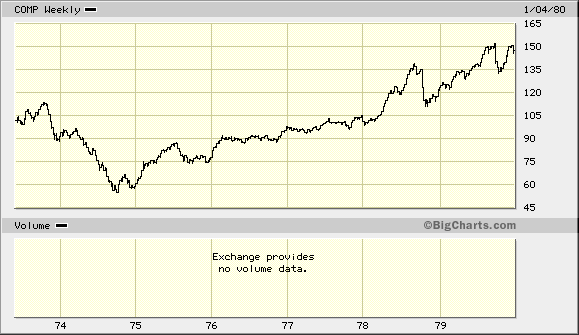Hi Don,
Thank you for your post. Always enlightening.
All that I'm suggesting is that a new secular bull market may have already started in the Nasdaq Composite, and this would be confirmed if the 2007 highs in it are broken. This still means most non-tech companies will be weighed down for another 3-9 years until the current secular bear market is over for them.
For example, this happened in 1974, when tech stocks started a new secular bull market (after topping in '66) even though most non-tech stocks didn't start making new multi-year highs until 1981 or shortly thereafter. By the end of the ‘70s, the NASDAQ experienced a blow-out performance on the upside compared to the Dow and it was clear that the tech stocks had begun their secular bull market earlier than most other stocks.
As I alluded to, if we take a look at stocks like Apple, Amazon, Priceline, Illumina, Intuit, etc. (not to mention companies like Baidu, Netflix, and Google which weren't around back in 2000), it's clear that certain components of the Nasdaq are already in secular bull markets. Additionally, relative strength of the Nasdaq vs the S&P suggests that a new high in the Nasdaq Composite could easily occur within the next several months. This will be a very important development if / when it happens.
To summarize, to me, the 2009 bottom is like the 1974 bottom.
The Nasdaq flew to the upside while the Dow and most other non-tech stocks continued to languish for another eight or so years.
Points taken, and they are
excellent ones Aly. Thanks. My point is more about semantics, and the way that I have compartmentalized trends over the years- in a way that "works" extremely well for me in understanding the context of each trend within larger cycles. Understanding the context of trends within larger trends keeps me grounded in a extreemly important way.
But your point about 2009 quite possibly being a bottom for certain components within that secular bear phase, as 1974 was for certain small caps -- is an important one - and it speaks to
leadership and stock selection during those times one is long within IT and cyclical bull phases {during what I steadfastly regard as a secular bear market

}. I address those in terms of relative strength and "leadrship stocks".
You mentioned >>>>As I alluded to, if we take a look at stocks like Apple, Amazon, Priceline, Illumina, Intuit, etc. (not to mention companies like Baidu, Netflix, and Google which weren't around back in 2000)<<<<
As you know I been trading many (most) of those names long and have posted the charts here at FF this year - some repeatedly.
So we are saying the same thing in a different way. Many thanks for your keen insight and keep up the great work. Regards, D
From SS.com:
We have screened the top performing stocks by relative strength, trading liquidity, earnings and revenue growth, and Investors Business Daily Composite Ranking, and have selected the twenty issues which we regard as the "hottest" issues for trading in October 2010. We will be trading in and out of these issues as opportunities are presented.
Rather than put images of each of those twenty here, we instead posted them at Fearless Forecasters here and by clicking on that link you can see all twenty charts updated right up to the minute at the time you click. The twenty are those consecutive charts at the end of that string beginning with AAPL and concluding with WBD.
As indicated above, we will look to trade in and out of these issues as opportunities are presented. The full list is as follows
AAPL (Apple Computer)
AMZN (Amazon)
ASYS (Amtech Systems)
BBD (Banco Bradesco)
BIDU (Baidu, Inc.)
BORN (China New Borun Corp.)
CTRP (Ctrip Com Intl Ltd)
DGP (Gold ETF)
EDC (Emerging Stock ETF)
FFIV (F5 Networks)
GOOG (Google)
LVS (Las Vegas Sands)
NFLX (Netflix)
ORCL (Oracle)
PCLN (Priceline)
RADS (Radiant Systems)
ROVI (Rovi Corp)
SCCO (Southern Copper)
SKWS (Skyworks Solutions)
WBD (William-Bill-Dann Foods)
Edited by IYB, 05 December 2010 - 05:48 PM.

























